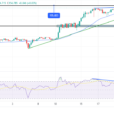The mixed U.S. economic data and political uncertainty continued to weigh on the U.S dollar. Even though activities in the manufacturing sector rose to a 13-year high in September and services sector expanded at the fastest pace in 12 years last month, the consumer prices rose just 0.5 percent in the month, below the 0.6 percent projected by experts, suggesting that increased job creation in these sectors has failed to pressure prices enough to validate Federal Reserve’s price projection.
This is one of the reasons the U.S. dollar dipped against its counterparts on Friday and will likely continue the trend this week after President Trump disavow Iran’s deal. However, the weak US dollar should deepen industrial production as seen in August and September, while Saudi Arabia’s decision to cut crude oil exports by 560,000 barrels per day in November is expected to further boost gasoline prices and subsequently pressure headline inflation towards the Federal Reserve’s 2% target in the final quarter of 2017.
However, the underlying fundamental factors would be temporary in accordance with Federal Reserve’s minutes of September 19-20 that showed policymakers are unclear if factors subduing inflation are just temporary or persistent. Therefore, they agreed that incoming data are imperative to rate decision.
Also, even though the odds of rate hike in December may increase with the rise in headline inflation figure, the US dollar may not respond proportionally for two reasons; December rates hike has already been priced in, two, growing uncertainty in the U.S. and President Trump’s inability to push through with tax cut just yet will weigh on the US dollar attractiveness.
Therefore, growing political uncertainties in the country and across the world remains a concern, especially with the whole Euro-area facing populist uprising amid stagnant Brexit negotiation.
This week, I will be looking at AUD/JPY, and NZD/JPY, NZD/USD, and AUD/USD from last week.












Leave A Comment